Interfacial Reactivity of the Filled Skutterudite Smy(FexNi1−x)4Sb12 in Contact with Liquid In-Based Alloys and Sn
Abstract
1. Introduction
2. Materials and Methods
2.1. Synthesis and Compositional Characterization of Substrates
2.2. Preparation of the Brazing Alloys
2.3. Sessile Drop Experiments
3. Results
3.1. Compositional and Morphological Characterization of Skutterudites
3.2. Wettability Study
3.2.1. AgCuIn Alloy
3.2.2. Sn
4. Discussion
5. Conclusions
Author Contributions
Funding
Acknowledgments
Conflicts of Interest
References
- Champier, D. Termoelectric generators: A review of applications. Energ. Convers. Manage 2017, 140, 167–181. [Google Scholar] [CrossRef]
- Domìnguez-Adame, F.; Martìn-Gonzàlez, M.; Sànchez, D.; Cantarero, A. Nanowires: A route to efficient thermoelectric devices. Phys. E 2019, 113, 213–225. [Google Scholar] [CrossRef]
- Chiwanga, S.; Tuley, R.; Placha, K.; Robbins, M.; Gilchrist, B.; Simpson, K. Automotive power harvesting/thermoelectric applications. In Thermoelectric Materials and Devices, 1st ed.; Iris Nandhakumar, I., White, N.M., Beeby, S., Eds.; Royal Society of Chemistry: Cambridge, UK, 2017; pp. 230–251. [Google Scholar]
- Mori, T.; Priya, S. Materials for energy harvesting: At the forefront of a new wave. MRS Bull. 2018, 43, 176–180. [Google Scholar] [CrossRef]
- Petsagkourakis, I.; Tybrandt, K.; Crispin, X.; Ohkubo, I.; Satoh, N.; Mori, T. Thermoelectric materials and applications for energy harvesting power generation. Sci. Tech. Adv. Mater. 2018, 19, 836–862. [Google Scholar] [CrossRef] [PubMed]
- Slack, G.A. New materials and performance limits for thermoelectric cooling. In CRC Handbook of Thermoelectrics, 1st ed.; Rowe, D.M., Ed.; Taylor and Francis: Boca Raton, FL, USA, 1995; pp. 407–439. [Google Scholar]
- Toberer, E.S.; May, A.F.; Snyder, G.J. Zintl chemistry for designing high efficiency thermoelectric materials. Chem. Mater. 2010, 22, 624–634. [Google Scholar] [CrossRef]
- Graf, T.; Felser, C.; Parkin, S.S.P. Simple rules for understanding of Heusler compounds. Prog. Solid State Chem. 2011, 39, 1–50. [Google Scholar] [CrossRef]
- Page, A.; Poudeu, P.F.P.; Uher, C. A first-principle approach to half-Heusler thermoelectrics: Accelerated prediction and understanding of materials properties. J. Materiomics 2016, 2, 104–113. [Google Scholar] [CrossRef]
- Chen, S.; Ren, Z. Recent progress of half-Heusler for moderate temperature thermoelectric applications. Mater. Today 2013, 16, 387–395. [Google Scholar] [CrossRef]
- Romaka, V.V.; Rogl, P.F.; Carlini, R.; Fanciulli, C. Prediction of the thermoelectric properties of half-Heusler phases from the density functional theory. In Alloys and Intermetallic Compounds: From Modeling to Engineering, 1st ed.; Artini, C., Ed.; CRC Press, Taylor & Francis Group: Boca Raton, FL, USA, 2017; pp. 286–323. [Google Scholar]
- Bos, J.-W.G.; Downie, R.A. Half-Heusler thermoelectrics: A complex class of materials. J. Phys. Condens. Matter 2014, 26, 433201. [Google Scholar] [CrossRef]
- He, R.; Zhu, H.; Chen, S. Half-heusler thermoelectrics. In Novel Thermoelectric Materials and Device Design Concepts, 1st ed.; Skipdarov, S., Nikitin, M., Eds.; Springer: Heidelberg, Germany, 2019; pp. 203–226. [Google Scholar]
- Dolyniuk, J.-A.; Owens-Baird, B.; Wang, J.; Zaikina, J.V.; Kovnir, K. Clathrate thermoelectrics. Mater. Sci. Eng. R Rep. 2016, 108, 1–46. [Google Scholar] [CrossRef]
- Kleinke, H. New bulk materials for thermoelectric power generation: Clathrates and complex antimonides. Chem. Mater. 2010, 22, 604–611. [Google Scholar] [CrossRef]
- Sales, B.C. Filled skutterudites. In Handbook on the Physics and Chemistry of Rare Earths, 1st ed.; Gschneidner, K.A., Jr., Bünzli, J.-C.G., Pecharsky, V.K., Eds.; North Holland: Amsterdam, The Netherlands, 2003; Volume 33, pp. 1–34. [Google Scholar]
- Uher, C. Skutterudite-Based Thermoelectrics. In Thermoelectrics Handbook—Macro to Nano, 1st ed.; Rowe, D.M., Ed.; Taylor and Francis: Boca Raton, FL, USA, 2005; Chapter 34; pp. 1–17. [Google Scholar]
- Carlini, R.; Fanciulli, C.; Boulet, P.; Record, M.C.; Romaka, V.V.; Rogl, P.F. Skutterudites for thermoelectric applications. Properties, synthesis and modelling. In Alloys and Intermetallic Compounds: From Modeling to Engineering, 1st ed.; Artini, C., Ed.; CRC Press, Taylor & Francis Group: Boca Raton, FL, USA, 2017; pp. 324–355. [Google Scholar]
- Rogl, G.; Rogl, P. Skutterudites, a most promising group of thermoelectric materials. Curr. Opin. Green Sustain. Chem. 2017, 4, 50–57. [Google Scholar] [CrossRef]
- Snyder, G.J.; Tang, Y.; Crawford, C.M.; Toberer, E.S. Recent progress in skutterudites. In Materials Aspects of Thermoelectricity, 1st ed.; Uher, C., Ed.; CRC Press, Taylor & Francis Group: Boca Raton, FL, USA, 2016; Chapter 19. [Google Scholar]
- Rogl, G.; Rogl, P. Skutterudites: Progress and challenges. In Novel Thermoelectric Materials and Device Design Concepts, 1st ed.; Skipidarov, S., Nikitin, M., Eds.; Springer: Cham, The Switzerland, 2019; pp. 177–201. [Google Scholar]
- Rogl, G.; Grytsiv, A.; Yubuta, K.; Puchegger, S.; Bauer, E.; Raju, C.; Mallik, R.C.; Rogl, P. In-doped multifilled n-type skutterudites with ZT = 1.8. Acta Mater. 2015, 95, 201–211. [Google Scholar] [CrossRef]
- Chapon, L.; Ravot, D.; Tedenac, J.C. Nickel-substituted skutterudites: Synthesis, structural and electrical properties. J. Alloys Compd. 1999, 282, 58–63. [Google Scholar] [CrossRef]
- Kaltzoglou, A.; Vaqueiro, P.; Knight, K.S.; Powell, A.V. Synthesis, characterization and physical properties of the skutterudites YbxFe2Ni2Sb12 (0 ≤ x ≤ 0.4). J. Solid State Chem. 2012, 193, 36–41. [Google Scholar] [CrossRef]
- Choi, S.; Kurosaki, K.; Ohishi, Y.; Muta, H.; Yamanaka, S. Thermoelectric properties of Tl-filled Co-free p-type skutterudites: Tlx(Fe,Ni)4Sb12. J. Appl. Phys. 2014, 115, 023702. [Google Scholar] [CrossRef]
- Rogl, G.; Grytsiv, A.; Heinrich, P.; Bauer, E.; Kumar, P.; Peranio, N.; Eibl, O.; Hork, J.; Zehetbauer, M.; Rogl, P. New bulk p-type skutterudites DD0.7Fe2.7Co1.3Sb12−xXx (X = Ge, Sn) reaching ZT > 1.3. Acta Mater. 2015, 91, 227–238. [Google Scholar] [CrossRef]
- Duan, F.; Zhang, L.; Dong, J.; Sakamoto, J.; Xu, B.; Li, X.; Tian, Y. Thermoelectric properties of Sn substituted p-type Nd filled skutterudites. J. Alloys Compd. 2015, 639, 68–73. [Google Scholar] [CrossRef]
- Bérardan, B.; Alleno, E.; Godart, C.; Rouleau, O.; Rodriguez-Carvajal, J. Preparation and chemical properties of the skutterudites (Ce–Yb)yFe4−x(Co/Ni)xSb12. Mater. Res. Bull. 2005, 40, 537–551. [Google Scholar] [CrossRef]
- Skomedal, G.; Holmgren, L.; Middleton, H.; Eremin, I.S.; Isachenko, G.N.; Jaegle, M.; Tarantik, K.; Vlachos, N.; Manoli, M.; Kyratsi, T.; et al. Design, assembly and characterization of silicide-based thermoelectric modules. Energy Convers. Manag. 2016, 110, 13–21. [Google Scholar] [CrossRef]
- Chen, S.W.; Hwader Chu, A.; Shan-Hill Wong, D. Interfacial reactions at the joints of CoSb3-based thermoelectric devices. J. Alloy Compd. 2017, 699, 448–454. [Google Scholar] [CrossRef]
- Salvador, J.R.; Cho, J.Y.; Ye, Z.; Moczygemba, J.E.; Thompson, A.J.; Sharp, J.W.; Koenig, J.D.; Maloney, R.; Thompson, T.; Sakamoto, J.; et al. Conversion efficiency of skutterudite-based thermoelectric modules. Phys. Chem. Chem. Phys. 2014, 16, 12510–12520. [Google Scholar] [CrossRef] [PubMed]
- Zhao, D.; Li, X.; He, L.; Jiang, W.; Chen, L. High temperature reliability evaluation of CoSb3/electrode thermoelectric joints. Intermetallics 2009, 17, 136–141. [Google Scholar] [CrossRef]
- Zhao, D.; Geng, H.; Chen, L. Microstructure contact Studies for skutterudite thermoelectric devices. Int. J. Appl. Ceram. Technol. 2012, 9, 733–741. [Google Scholar] [CrossRef]
- Zhao, D.; Li, X.; He, L.; Jiang, W.; Chen, L. Interfacial evolution behaviour and reliability evaluation of CoSb3/Ti/Mo–Cu thermoelectric joints during accelerated thermal aging. J. Alloy Compd. 2009, 477, 425–431. [Google Scholar] [CrossRef]
- Fan, J.; Chen, L.; Bai, S.; Shi, X. Joining of Mo to CoSb3 by spark plasma sintering by inserting a Ti interlayer. Mater. Lett. 2004, 58, 3876–3878. [Google Scholar] [CrossRef]
- Chen, W.; Chen, S.; Tseng, S.; Hsiao, H.; Chen, Y.; Snyder, G.J.; Tang, Y. Interfacial reactions in Ni/CoSb3 couples at 450 °C. J. Alloy Compd. 2015, 632, 500–504. [Google Scholar] [CrossRef]
- Shi, L.; Huang, X.; Gu, M.; Chen, L. Interfacial structure and stability in Ni/SKD/Ti/Ni skutterudite thermoelements. Surf. Coat. Technol. 2016, 285, 312–317. [Google Scholar] [CrossRef]
- Kaszyca, K.; Schmidt, M.; Chmielewski, M.; Pietrzak, K.; Zybala, R. Joining of thermoelectric material with metallic electrode using Spark Plasma Sintering (SPS) technique. Mater. Today Proc. 2018, 5, 10277–10282. [Google Scholar] [CrossRef]
- Song, B.; Lee, S.; Cho, S.; Song, M.-J.; Choi, S.-M.; Seo, W.-S.; Yoon, Y.; Lee, W. The effects of diffusion barrier layers on the microstructural and electrical properties in CoSb3 thermoelectric modules. J. Alloy Compd. 2014, 617, 160–162. [Google Scholar] [CrossRef]
- García-Cañadas, J.; Powell, A.V.; Kaltzoglou, A.; Vaqueiro, P.; Min, G. Fabrication and evaluation of a skutterudite-based thermoelectric module for high-temperature applications. J. Electron. Mater. 2013, 42, 1369–1374. [Google Scholar] [CrossRef]
- Wojciechowski, K.T.; Zybala, R.; Mania, R. High temperature CoSb3-Cu junctions. Microelectron. Reliab. 2011, 51, 1198–1202. [Google Scholar] [CrossRef]
- Massaslki, T. Binary Alloy Phase Diagrams, 2nd ed.; ASM International: Materials Park, OH, USA, 1990. [Google Scholar]
- Carlini, R.; Khan, A.U.; Ricciardi, R.; Mori, T.; Zanicchi, G. Synthesis, characterization and thermoelectric properties of Sm filled Fe4-xNixSb12. J. Alloy Compd. 2016, 655, 321–326. [Google Scholar] [CrossRef]
- Artini, C.; Latronico, G.; Carlini, R.; Saini, S.; Takeuchi, T.; Choi, S.; Baldini, A.; Anselmi-Tamburini, U.; Valenza, F.; Mele, P. Effect of different processing routes on the power factor of the filled skutterudite Smy(FexNi1−x)4Sb12 (x = 0.50–0.80; y = 0.12–0.53). ES Mater. Manuf. 2019, 5, 29–37. [Google Scholar] [CrossRef]
- Artini, C.; Carlini, R.; Spotorno, R.; Failamani, F.; Mori, T.; Mele, P. Structural properties and thermoelectric performance of the double filled skutterudite (Sm,Gd)y(FexNi1−x)4Sb12. Materials 2019, 12, 2451. [Google Scholar] [CrossRef]
- Artini, C.; Fanciulli, C.; Zanicchi, G.; Costa, G.; Carlini, R. Thermal expansion and high temperature structural features of the filled skutterudite Smβ(FeαNi1−α)4Sb12. Intermetallics 2017, 87, 31–37. [Google Scholar] [CrossRef]
- Artini, C.; Castellero, A.; Baricco, M.; Buscaglia, M.T.; Carlini, R. Structure, microstructure and microhardness of rapidly solidified Smy(FexNi1−x)4Sb12 (x = 0.45, 0.50, 0.70, 1) thermoelectric compounds. Solid State Sci. 2018, 79, 71–78. [Google Scholar] [CrossRef]
- Artini, C.; Zanicchi, G.; Costa, G.A.; Carnasciali, M.M.; Fanciulli, C.; Carlini, R. Correlations between structural and electronic properties in the filled skutterudite Smy(FexNi1−x)4Sb12. Inorg. Chem. 2016, 55, 2574–2583. [Google Scholar] [CrossRef]
- Artini, C.; Carlini, R. Influence of composition and thermal treatments on microhardness of the filled skutterudite Smy(FexNi1−x)4Sb12. J. Nanosci. Nanotechnol. 2017, 17, 1634–1639. [Google Scholar] [CrossRef]
- Carlini, R.; Parodi, N.; Soggia, F.; Latronico, G.; Carnasciali, M.; Artini, C. Corrosion behavior of Smy(FexNi1−x)4Sb12 (0.40 ≤ x ≤ 0.80) in sodium chloride solutions studied by electron microscopy and ICP-AES. J. Mater. Eng. Perform. 2018, 27, 6266. [Google Scholar] [CrossRef]
- Spotorno, R.; Ghiara, G.; Carlini, R.; Latronico, G.; Mele, P.; Artini, C. Corrosion of the filled skutterudite Smy(FexNi1−x)4Sb12 (x = 0.40, 0.80) by NaCl solutions: An electrochemical study. J. Electron. Mater. [CrossRef]
- Artini, C.; Parodi, N.; Latronico, G.; Carlini, R. Formation and decomposition process of the filled skutterudite Smy(FexNi1−x)4Sb12 (0.40 ≤ x ≤ 1) as revealed by differential thermal analysis. J. Mater. Eng. Perform. 2018, 27, 6259–6265. [Google Scholar] [CrossRef]
- Cook III, G.O.; Sorensen, C.D. Overview of transient liquid phase and partial transient liquid phase bonding. J. Mater. Sci. 2011, 46, 5305–5323. [Google Scholar] [CrossRef]
- Valenza, F.; Gambaro, S.; Muolo, M.L.; Salvo, M.; Casalegno, V. Wetting of SiC by Al-Ti alloys and joining by in-situ formation of interfacial Ti3Si(Al)C2. J. Eur. Cer. Soc. 2018, 38, 3727–3734. [Google Scholar] [CrossRef]
- Jung, D.H.; Sharma, A.; Mayer, M.; Jung, J.P. A review on recent advances in transient liquid phase (TLP) bonding for thermoelectric power module. Rev. Adv. Mater. Sci. 2018, 53, 147–160. [Google Scholar] [CrossRef]
- Hong, S.M.; Glaeser, A.M. Reduced-temperature Transient-Liquid-Phase Bonding of Alumina using a Ag-Cu-based brazing alloy. In Proceedings of the 3rd International Brazing and Soldering Conference, San Antonio, TX, USA, 24–26 April 2006; Stephens, J.J., Weil, K.S., Eds.; ASM International: Novelty, OH, USA, 2006. [Google Scholar]
- Lee, C.C.; So, W.W. High temperature silver-indium joints manufactured at low temperature. Thin Solid Films 2000, 366, 196–201. [Google Scholar] [CrossRef]
- Weast, R.C. Handbook of Chemistry and Physics, 56th ed.; CRC Press: Cleveland, OH, USA, 1975. [Google Scholar]
- Valenza, F.; Muolo, M.L.; Passerone, A.; Glaeser, A.M. Wetting and interfacial phenomena in relation to joining of alumina via Co/Nb/Co interlayers. J. Eur. Ceram. Soc. 2013, 33, 539–547. [Google Scholar] [CrossRef]
- Sharma, R.C.; Ngai, T.L.; Chang, Y.A. The In-Sb (Indium-Antimony) System. Bull. Alloy Phase Diag. 1989, 10, 657–664. [Google Scholar] [CrossRef]
- Singler, T.J.; Su, S.; Yin, L.; Murray, B.T. Modeling and experiments in dissolutive wetting: A review. J. Mater. Sci. 2012, 47, 8261–8274. [Google Scholar] [CrossRef]
- Okamoto, H. Sb-Sn (Antimony-Tin). J. Phase Equilibria Diffusion. 2012, 33, 347. [Google Scholar] [CrossRef][Green Version]
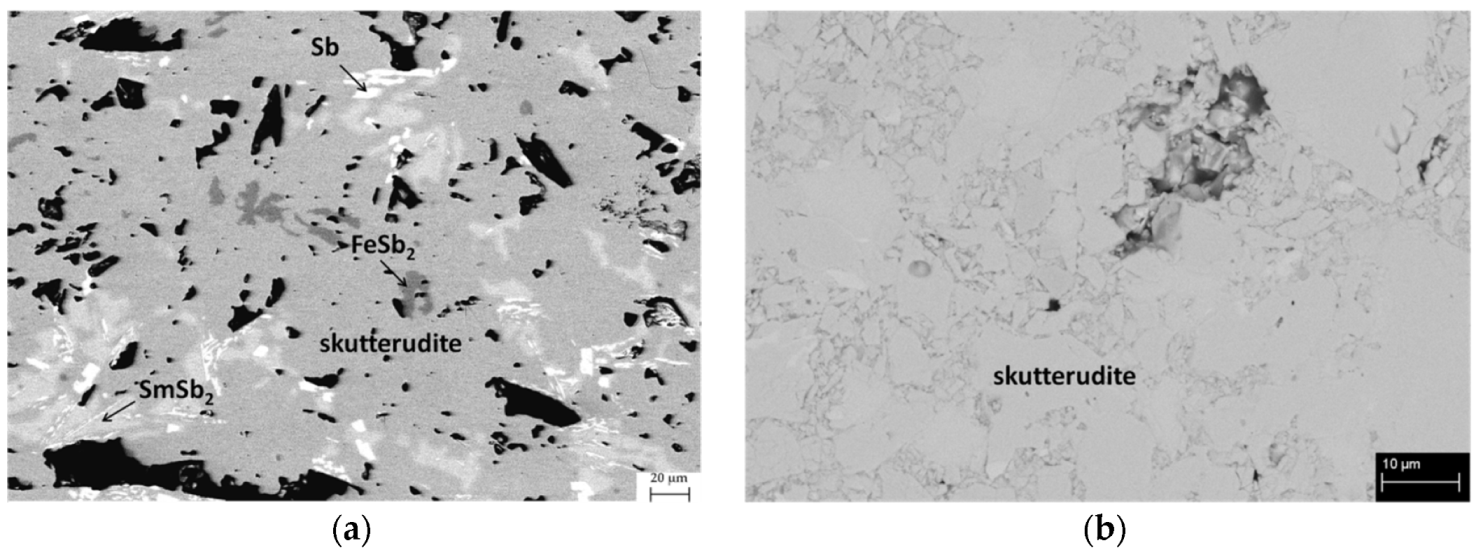

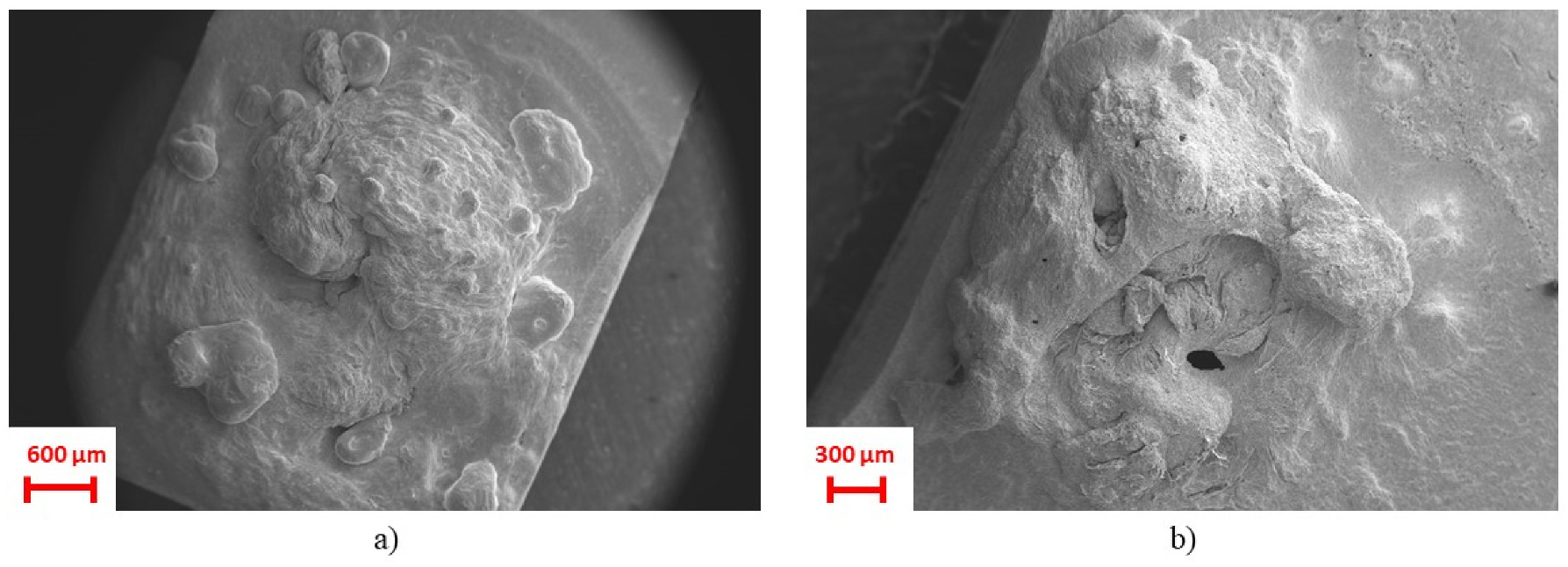
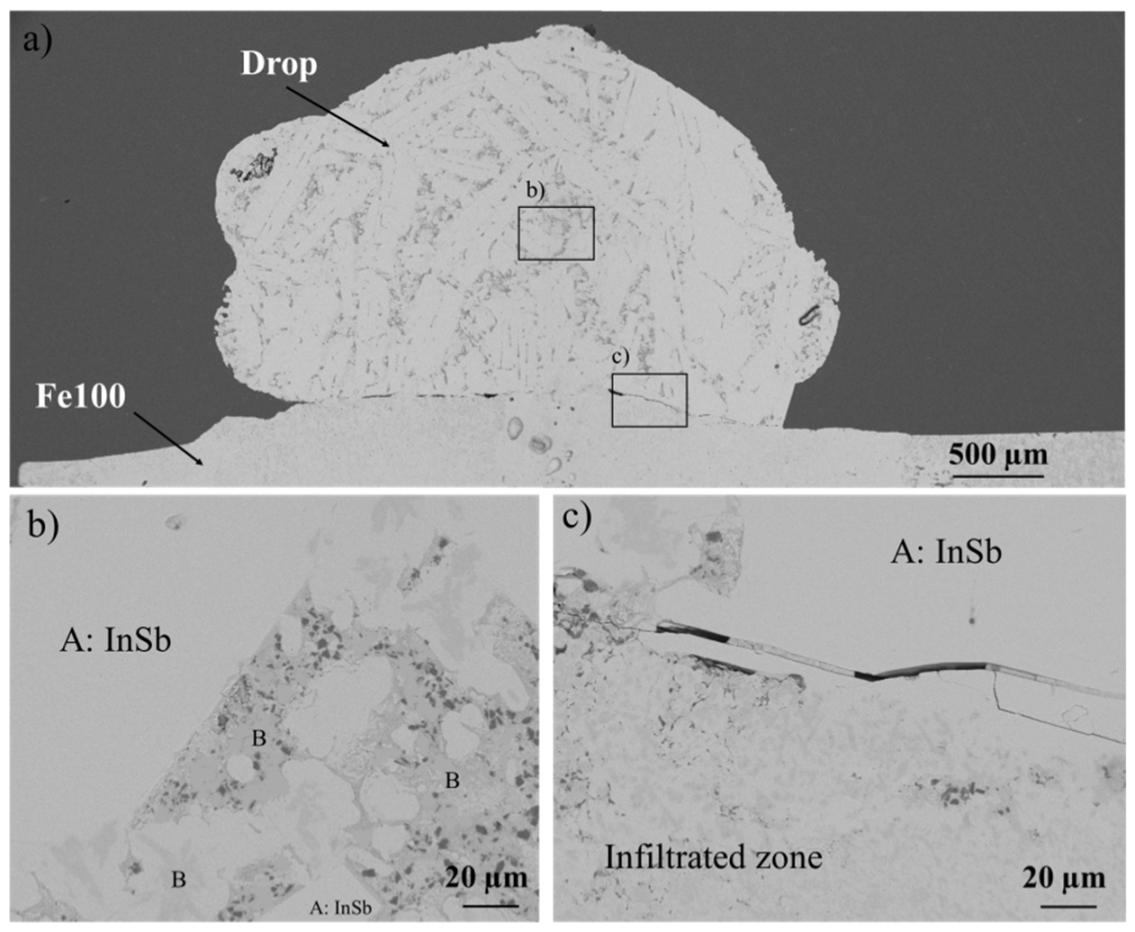


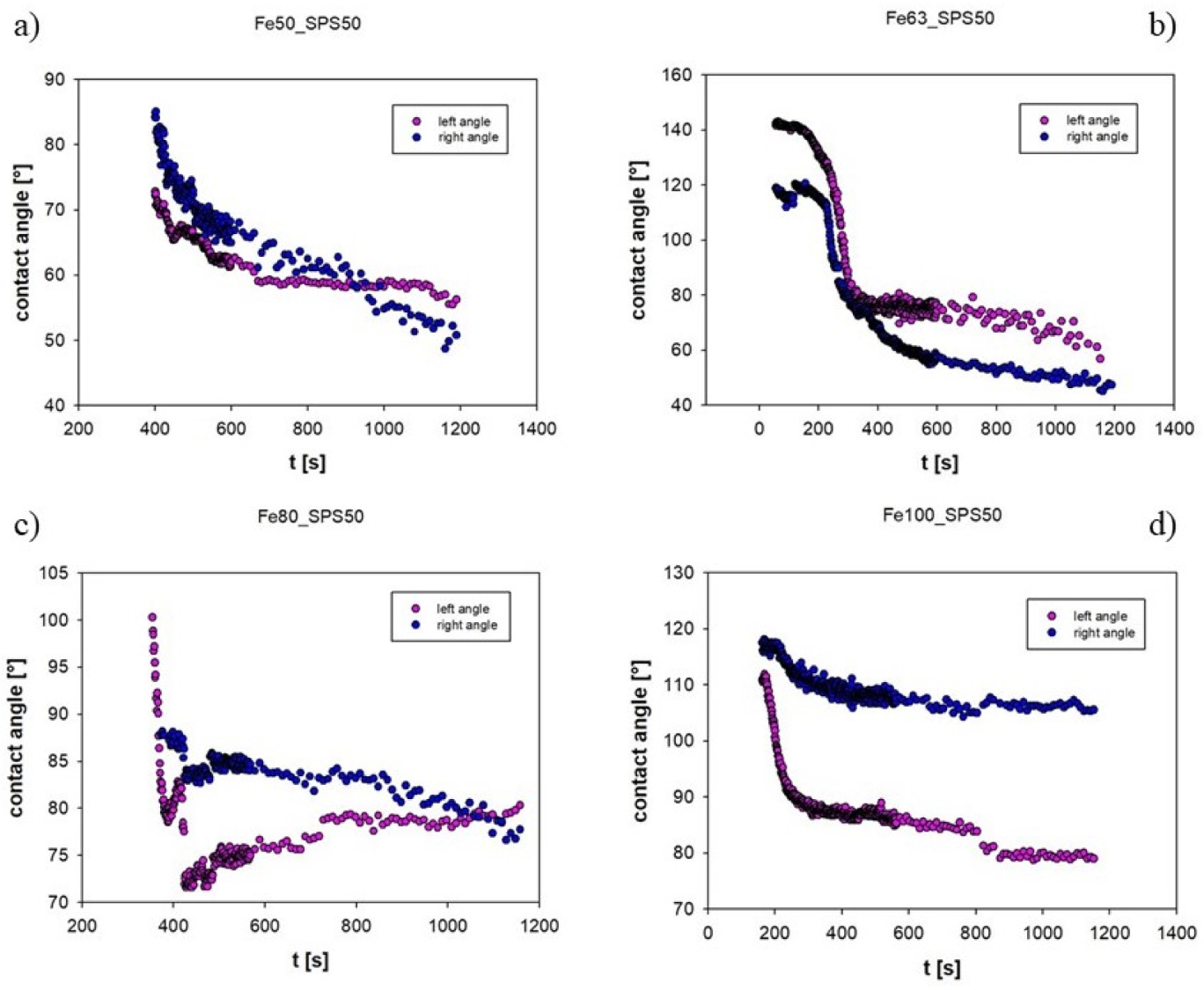
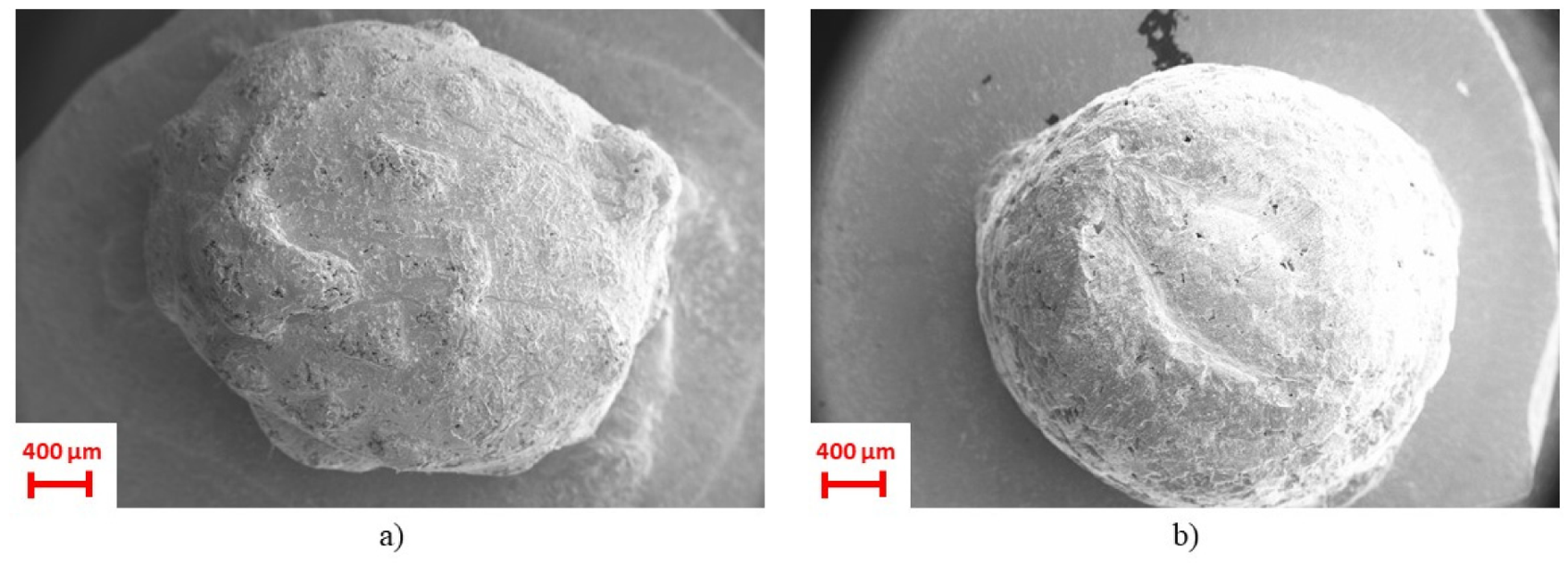
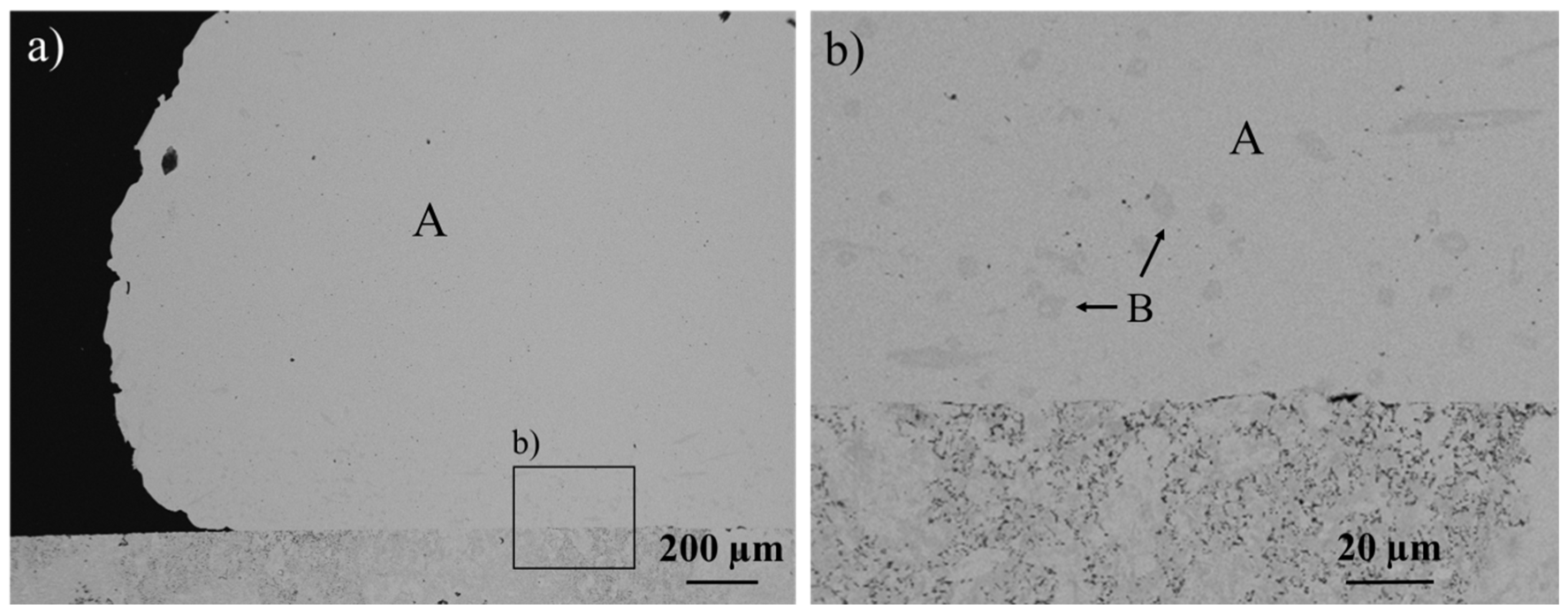
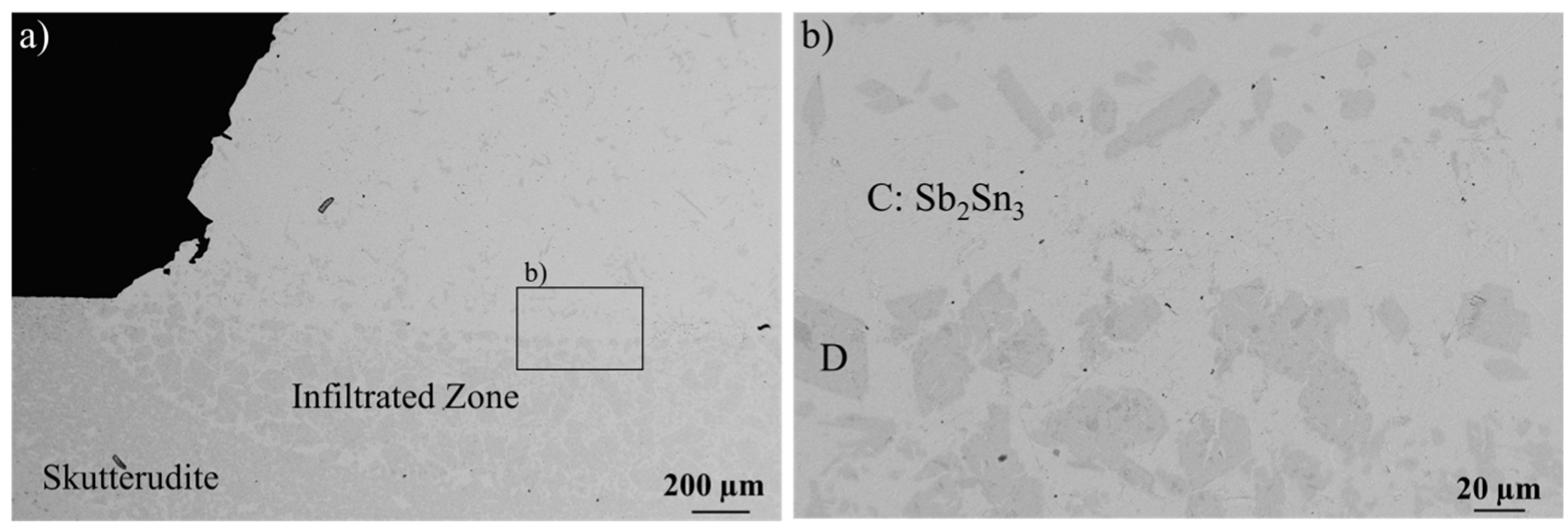
| Sample | Experimental Composition | Additional Phases (before SPS) |
|---|---|---|
| Fe100 | Sm0.75(3)(Fe0.95(1))4Sb12 | Sb, SmSb2, FeSb2 |
| Fe80 | Sm0.53(4)(Fe0.74(1)Ni0.20(1))4Sb12 | Sb, SmSb2 |
| Fe63 | Sm0.33(3)(Fe0.60(1)Ni0.34(1))4Sb12 | - |
| Fe50 | Sm0.12(3)(Fe0.47(1)Ni0.47(1))4Sb12 | Sb, (Fe,Ni)SmSb3 |
| Sample | Region | Fe | Ni | Sb | Sm | Ag | Cu | In | Possible Phase |
|---|---|---|---|---|---|---|---|---|---|
| Fe100-AgCuIn | A | - | - | 50.0 | 0.1 | - | - | 49.9 | InSb |
| B | 3.5 | - | 15.0 | 1.0 | 6.2 | 3.2 | 71.1 | - | |
| Fe50-AgCuIn | C | - | - | 50.3 | - | - | - | 49.7 | InSb |
| D | 20.3 | 13.1 | 65.8 | 0.4 | - | 0.4 | - | - |
| Sample | Left Angle | Right Angle |
|---|---|---|
| Fe50_SPS | 55° | 55° |
| Fe63_SPS | 70° | 50° |
| Fe80_SPS | 80° | 80° |
| Fe100_SPS | 80° | 105° |
| Sample | Region | Fe | Ni | Sb | Sm | Sn | Possible Phase |
|---|---|---|---|---|---|---|---|
| Fe100-Sn | A | 0.6 | - | 19.7 | 0.2 | 86.9 | Sn(Sb) + Sb2Sn3 |
| B | 32.3 | - | 6.7 | 0.3 | 60.7 | FeSn2 | |
| Fe50-Sn | C | 0.1 | 0.1 | 43.3 | - | 56.5 | Sb2Sn3 |
| D | 16.2 | 16.2 | 56.3 | 0.4 | 10.9 | (Fe, Ni) Sb(Sn)2 |
© 2020 by the authors. Licensee MDPI, Basel, Switzerland. This article is an open access article distributed under the terms and conditions of the Creative Commons Attribution (CC BY) license (http://creativecommons.org/licenses/by/4.0/).
Share and Cite
Latronico, G.; Valenza, F.; Carlini, R.; Mele, P.; Artini, C. Interfacial Reactivity of the Filled Skutterudite Smy(FexNi1−x)4Sb12 in Contact with Liquid In-Based Alloys and Sn. Metals 2020, 10, 364. https://doi.org/10.3390/met10030364
Latronico G, Valenza F, Carlini R, Mele P, Artini C. Interfacial Reactivity of the Filled Skutterudite Smy(FexNi1−x)4Sb12 in Contact with Liquid In-Based Alloys and Sn. Metals. 2020; 10(3):364. https://doi.org/10.3390/met10030364
Chicago/Turabian StyleLatronico, Giovanna, Fabrizio Valenza, Riccardo Carlini, Paolo Mele, and Cristina Artini. 2020. "Interfacial Reactivity of the Filled Skutterudite Smy(FexNi1−x)4Sb12 in Contact with Liquid In-Based Alloys and Sn" Metals 10, no. 3: 364. https://doi.org/10.3390/met10030364
APA StyleLatronico, G., Valenza, F., Carlini, R., Mele, P., & Artini, C. (2020). Interfacial Reactivity of the Filled Skutterudite Smy(FexNi1−x)4Sb12 in Contact with Liquid In-Based Alloys and Sn. Metals, 10(3), 364. https://doi.org/10.3390/met10030364









